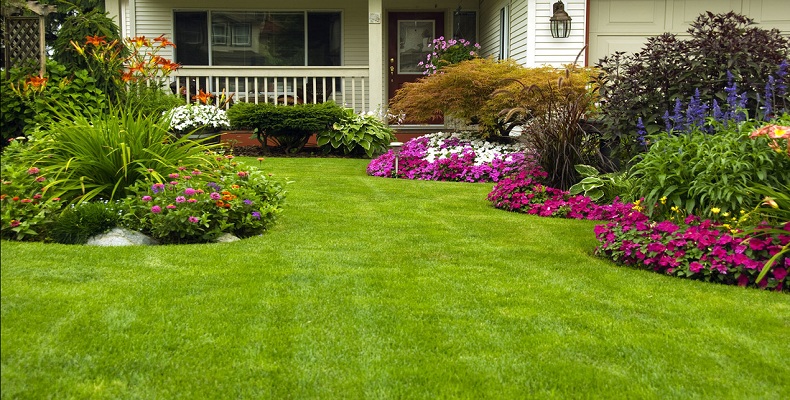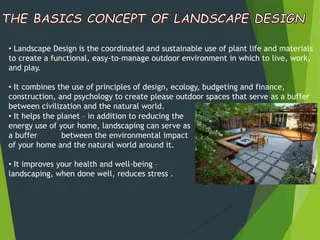Excitement About Landscape Design
Table of ContentsLandscape Design - The FactsNot known Details About Landscape Design Landscape Design Can Be Fun For EveryoneOur Landscape Design Statements
Official style theme. Credit Scores: Gail Hansen, UF/IFAS The yard is an extension of the home where a range of activities take place. A yard can usually be separated into 3 areas: public (the front yard), exclusive (the garden), and service (normally the side yard). The location of task areas depends mostly on the kind of location, the dimension of room needed, the sort of activity, and the preferred proximity to other tasks and structures (Landscape Design).
The outdoors wall of the house often offers as the initial wall or beginning point of an outdoor area. Inappropriate uses need to be divided, and associated activities, such as cooking and eating, need to be placed together to make the yard extra effective and enjoyable. When making use of hardscape to create rooms, utilize construction material comparable to that used in the residence for continuity from the home right into the garden.
Linked areas. Credit: Gail Hansen, UF/IFAS Utilizing comparable hardscape functions and duplicating plants pulls the eye around the garden.
From a style viewpoint, plant products have three significant functions in the landscape: aesthetic, structural and practical. Visually, plants create an aesthetically pleasurable atmosphere and structurally plants organize and define areas.
All About Landscape Design
For psychological convenience plants are used as physical or suggested barriers for personal privacy and safety. Physical obstacles block both the view and access to a space and include fences, wall surfaces and plant bushes. Landscape Design. Suggested barriers, usually reduced growing plants, block accessibility yet not the sight (Number 9). Other functions of plants include cleaning up the air, preventing disintegration and soil loss, keeping dampness in the dirt, and returning raw material to the dirt.
Physical and implied obstacles. Debt: Gail Hansen, UF/IFAS For these reasons, the sorts of plants to be utilized (such as trees, bushes, or groundcovers) should be selected in the early phases of planning. Plant kinds are chosen for their practical capabilities so that their future function and required space can be thought about at the very same time.
The overhead plane, the upright aircraft and the ground plane need to all be taken into consideration to create enclosure. When the form of a plant bed has actually been established, the plants ought to be massed (organized) and split to attain aesthetic unity and the wanted amount of unit. The size of a plant mass will rely on the complete dimension of the lawn, the dimension of the individual plants in the mass, and the focus or influence wanted from the plant material.
Each plant mass is in front of, behind, or next to, one more mass. Credit History: Gail Hansen, UF/IFAS Repeating plants within a mass and repeating masses with similar plants ties the garden together. The private plant qualities have to be taken into consideration to effectively layer and mass plants.
Landscape Design Fundamentals Explained
All plant compositions start with the major structure plants, the huge, mainly evergreen history plants-such as the trees and huge shrubs. These plants separate or enframe rooms, manage the size of the space, and supply the starting point for picking the proper attributes of the 2nd layer, midground plants, for massing and infill.
Crucial points in the yard ought to be highlighted by the usage of special plants, distinctive structures, or garden accessories. Noting thresholds or entries to this website spaces can be made with entrances, arbors, and actions, or through using one-of-a-kind and colorful plants. The form and/or style theme of the yard will typically help establish the crucial points and just how they need to be highlighted.
Various other important areas in the lawn are prime focus, which is used to aesthetically arrange a designed location. The kind of centerpiece commonly depends on the seeing viewpoint. Different perspectives or perspectives can reveal different compositions in the landscape that might call for a range of focal factors. Contrasting appearance, form, dimension and shade will certainly capture and hold the eye.
3 Easy Facts About Landscape Design Described
Plant forms. Credit Rating: Gail Hansen, UF/IFAS After type, texture is the next leading feature of a plant; rugged, medium and fine appearances can be made use of for comparison and emphasis in the landscape.


The enjoyable scent of plants, the audio of wind in the trees, the noise and texture of water, and the shades and textures of sculptures, pots and yard furniture all include in the experience of the yard. One detail that is often ignored is the result of light on the aesthetics of the plants.
The entire yard modifications in feature and appearance over the training course of the day, and the program of a year, as the light and temperature change from morning to night and season Bonuses to period. Plant choice should take into consideration a plant's development rate, its mature dimension and kind, and the maintenance it will certainly need.
It is essential to know the ultimate fully grown dimension of plants so they can be positioned in the right location and spaced properly when they are installed. Offering plants room to expand is a challenge due to the fact that the typical fully grown dimension is normally based on ideal expanding problems and the ecological conditions of a website might important source create a plant to enlarge or stay smaller.